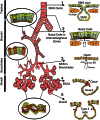Cell-based therapies for lung disease
- PMID: 22279079
- PMCID: PMC3695661
- DOI: 10.1093/bmb/ldr051
Cell-based therapies for lung disease
Abstract
Introduction or background: The adult lung is a complex organ whose large surface area interfaces extensively with both the environment and circulatory system. Yet, in spite of the high potential for exposure to environmental or systemic harm, epithelial cell turnover in adult lung is comparatively slow. Moreover, loss of lung function with advancing age is becoming an increasingly costly healthcare problem. Cell-based therapies stimulating endogenous stem/progenitor cells or supplying exogenous ones have therefore become a prime translational goal. Alternatively when lung repair becomes impossible, replacement with tissue-engineered lung is an attractive emerging alternative using a decellularized matrix or bioengineered scaffold.
Sources of data: Endogenous and exogenous stem cells for lung therapy are being characterized by defining developmental lineages, surface marker expression, functions within the lung and responses to injury and disease. Seeding decellularized lung tissue or bioengineered matrices with various stem and progenitor cells is an approach that has already been used to replace bronchus and trachea in human patients and awaits further development for whole lung tissue.
Areas of agreement: Cellular therapies have clear potential for respiratory disease. However, given the surface size and complexity of lung structure, the probability of a single cellular population sufficing to regenerate the entire organ, as in the bone marrow, remains low. Hence, lung regenerative medicine is currently focused around three aims: (i) to identify and stimulate resident cell populations that respond to injury or disease, (ii) to transplant exogenous cells which can ameliorate disease and (iii) to repopulate decellularized or bioengineered lung matrix creating a new implantable organ.
Areas of controversy: Lack of consensus on specific lineage markers for lung stem and progenitor cells in development and disease constrains transferability of research between laboratories and sources of cellular therapy. Furthermore, effectiveness of individual cellular therapies to correct gas exchange and provide other critical lung functions remains unproven. Finally, feasibility of autologous whole organ replacement has not been confirmed as a durable therapy. Growing points Cellular therapies for lung regeneration would be enhanced by better lineage tracing within the lung, the ability to direct differentiation of exogenous stem or progenitor cells, and the development of functional assays for cellular viability and regenerative properties. Whether endogenous or exogeneous cells will ultimately play a greater therapeutic role remains to be seen. Reducing the need for lung replacement via endogenous cell-mediated repair is a key goal. Thereafter, improving the potential of donor lungs in transplant recipients is a further area where cell-based therapies may be beneficial. Ultimately, lung replacement with autologous tissue-engineered lungs is another goal for cell-based therapy. Areas timely for developing research Defining 'lung stem or progenitor cell' populations in both animal models and human tissue may help. Additionally, standardizing assays for assessing the potential of endogenous or exogenous cells within the lung is important. Understanding cell-matrix interactions in real time and with biomechanical insight will be central for lung engineering. Cautionary note Communicating the real potential for cell-based lung therapy needs to remain realistic, given the keen expectations of patients with end-stage lung disease.
Figures


Similar articles
-
Mesenchymal stem cells for therapeutic applications in pulmonary medicine.Br Med Bull. 2015 Sep;115(1):45-56. doi: 10.1093/bmb/ldv026. Epub 2015 Jun 10. Br Med Bull. 2015. PMID: 26063231 Review.
-
Organ reconstruction: Dream or reality for the future.Biomed Mater Eng. 2017;28(s1):S121-S127. doi: 10.3233/BME-171633. Biomed Mater Eng. 2017. PMID: 28372287 Review.
-
Endogenous and exogenous stem cells: a role in lung repair and use in airway tissue engineering and transplantation.J Biomed Sci. 2010 Dec 7;17(1):92. doi: 10.1186/1423-0127-17-92. J Biomed Sci. 2010. PMID: 21138559 Free PMC article. Review.
-
Tissue engineering technologies: just a quick note about transplantation of bioengineered donor trachea and augmentation cystoplasty by de novo engineered bladder tissue.G Chir. 2009 Nov-Dec;30(11-12):514-9. G Chir. 2009. PMID: 20109384 Review.
-
The development of the bioartificial lung.Br Med Bull. 2014 Jun;110(1):35-45. doi: 10.1093/bmb/ldt037. Epub 2013 Dec 18. Br Med Bull. 2014. PMID: 24352896 Review.
Cited by
-
The modulation of enzyme indoleamine 2,3-dioxygenase from dendritic cells for the treatment of type 1 diabetes mellitus.Drug Des Devel Ther. 2017 Jul 24;11:2171-2178. doi: 10.2147/DDDT.S135367. eCollection 2017. Drug Des Devel Ther. 2017. PMID: 28769554 Free PMC article. Review.
-
Stem cells, cell therapies, and bioengineering in lung biology and diseases. Comprehensive review of the recent literature 2010-2012.Ann Am Thorac Soc. 2013 Oct;10(5):S45-97. doi: 10.1513/AnnalsATS.201304-090AW. Ann Am Thorac Soc. 2013. PMID: 23869446 Free PMC article. Review.
-
Differentiation of Club Cells to Alveolar Epithelial Cells In Vitro.Sci Rep. 2017 Jan 27;7:41661. doi: 10.1038/srep41661. Sci Rep. 2017. PMID: 28128362 Free PMC article.
-
Cell-based therapy in lung regenerative medicine.Regen Med Res. 2014 Apr 11;2(1):7. doi: 10.1186/2050-490X-2-7. eCollection 2014 Dec. Regen Med Res. 2014. PMID: 25984335 Free PMC article. Review.
-
Lung Extracellular Matrix as a Platform for Lung Organ Bioengineering: Design and Development of Tissue Engineered Lung.Adv Exp Med Biol. 2021;1345:35-46. doi: 10.1007/978-3-030-82735-9_4. Adv Exp Med Biol. 2021. PMID: 34582012 Review.
References
-
- Giangreco A, Groot KR, Janes SM. Lung cancer and lung stem cells: strange bedfellows? Am J Respir Crit Care Med. 2007;175:547–53. - PubMed
Publication types
MeSH terms
Grants and funding
LinkOut - more resources
Full Text Sources
Medical
Research Materials

